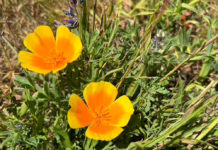The support group for the Sonoma County Wine Library, the Wine
Library Associates of Sonoma County, will host an evening of wine,
food and wine history featuring Helen and Charles Bacigalupi.
Listen to the Bacigalupi’s story and taste stellar wines made from
their vineyards, together with great hors d’oeuvres from Park
Avenue Catering, at Paradise Ridge Winery, 4545 Thomas Lake Harris
Drive in Santa Rosa, on Friday, Feb. 25 at 7 p.m. Reservations are
$45 for non Wine Library Associates and $30 for Associates, and can
be made by calling 433-1660.
Helen and Charles Bacigalupi have been selected and interviewed
as part of the Sonoma County Wine Library’s oral history program.
Join them in intimate conversation with their oral history
interviewer, author Vivienne Sosnowski, as they relate rich
resonant stories from their fifty-six years of wine growing. Their
odyssey covers the emergence of the Sonoma County and the North
Coast as leading areas in the production of fine wine worldwide.
Helen and Charles have been there from the days when grapes sold
for a few dollars a ton, when it was blended into jug wine, and
when growers were at the mercy of a few huge wineries that set the
prices arbitrarily and only after the grapes were delivered. One of
their crowning moments was when Miljenko “Mike” Grgich selected
their Chardonnay to go into the 1973 Chateau Montelena wine that
became the white wine that won the Judgment of Paris in 1976.
Besides being complete professionals, the Bacigalupis love
growing wine grapes. With all its tedium and terror, there is
something wonderful about living among the vines, and making a
living from them. The down side includes driving a tractor for
endless hours dusting the vines with sulphur to keep them from
rotting, being at the mercy of the weather that can be too cool for
much of the summer and then spike to 110 for long enough to fry
your grapes into raisins, enduring fluctuating grape prices and
fickle, demanding wineries. Part of the payoff lies in the sure
knowledge that you can artfully arrange stubborn vegetative matter
on trellises, nurture its fruit until it has gained the
complexities and nuances that mark it as world class and then
harvest it at just the right moment with speed and precision. And
part of the payoff lies in living among the vines, the sheer beauty
of the landscape you helped sculpt and that sustains you is vivid
and staggering. Sunsets explode with soft intensity, colors
multiplying beyond any names. On some dank mornings the pruned
vines rise from river mist so ground-hugging the cordons appear
like free floating arms.
Joe Mesics was another grape grower who really loved grapes and
grape farming. Joe Mesics died on February 1, 2011. He was a great
guy, and we who knew him and loved him will miss him deeply. His
daughter Margreta “Greta” Mesics summed his essence and particulars
with skill and passion in her eloquent obituary in this paper last
week. With his death, Joe’s secret identity as Fjuel Gangbardt was
revealed, and the Healdsburg Tribune, in addition to running the
fine obit, carried one of Gangbardt’s better columns. I excerpt
below a part of another one. In this one Joe goes on about the
flowering of grapevines, and what might happen if you were lucky
enough to be there with a companion.
The early summer sun, high in a cloudless sky bodes well for a
decent flowering. You stand off from the vines absorbing this
blessing. A deep breath of growers’ pleasure.
Then, “What’s that?” you ask your companion if you’re fortunate
enough to not be alone and thus able to share this once in a
lifetime experience with someone else.
“What’s what?” she replies.
“That smell, do you get it?”
“Oh my goodness, it’s flowers! Where are they? It’s lemony, no
lavender, no lighter than that — vanilla? No, much lighter,
attractive, sexy, gorgeous.”
You turn toward the vineyard, sniffing for a clue. Then you
realize you are smelling thousands, no billions of tiny flowers on
the vines that quite recently were pruned brown sticks with dusty
buds hidden on them. These flowers, half the size of a small ant
are arranged on what will become a cluster of delicious grapes. The
flowers are tiny white simple openings, yellow in the central parts
that pop out in the sunshine, shedding the cap that has protected
them all winter. Now each flower needs pollination to produce fruit
for the grower.
This flower’s aroma is not strong like a gardenia or lily of the
valley. It is a smell as light as a breeze, and there must be no
breeze to ever experience it. You and your lucky companion stand
still, breathing it in. You’re experiencing something even life
long growers often miss, the delicate, oh so delicate odor of grape
nectaries. Nectaries that produce the offering to insects for their
part in pollination. You know, the birds and the bees.
This from Joe’s column, “Vit Lit” in the Healdsburg Tribune, May
22, 2008.
Bo Simons is the Wine Librarian. He can be reached at **@***********ca.us or
433-3772.
94
F
Healdsburg
July 11, 2025








